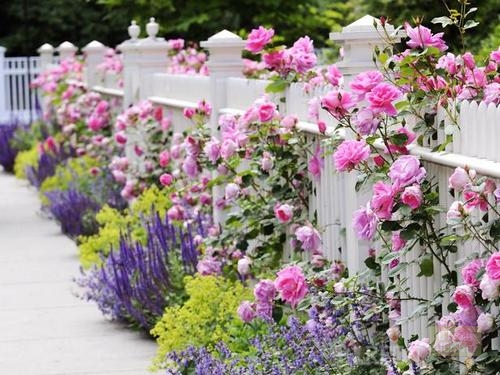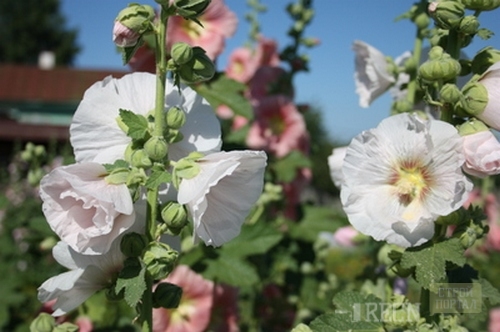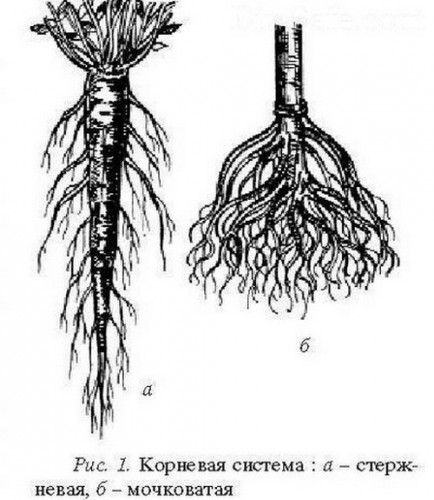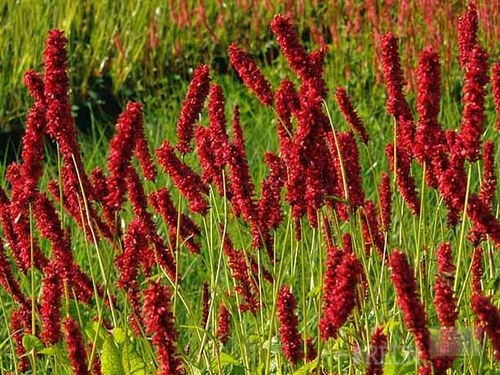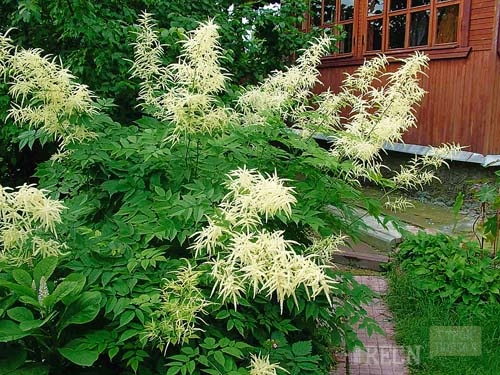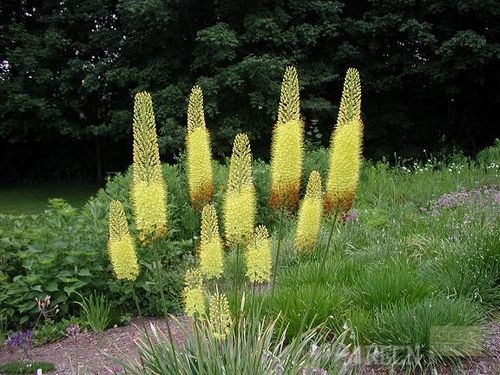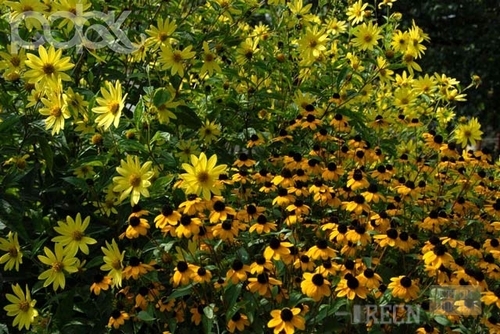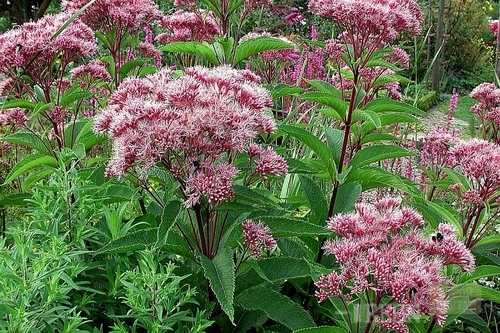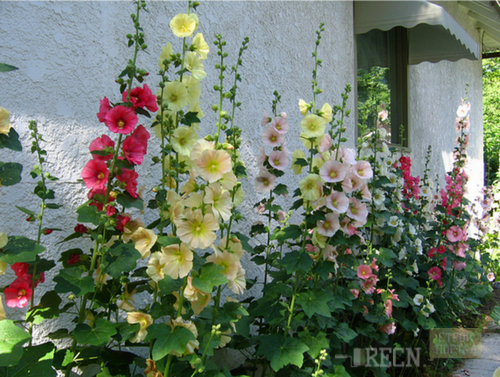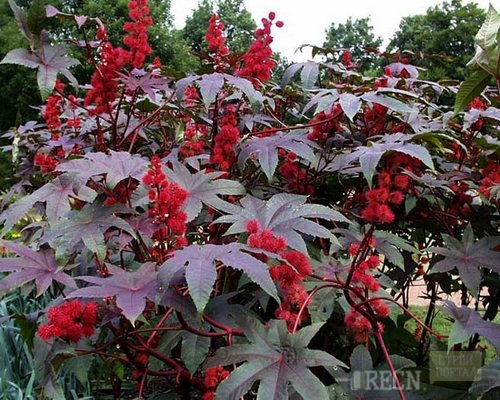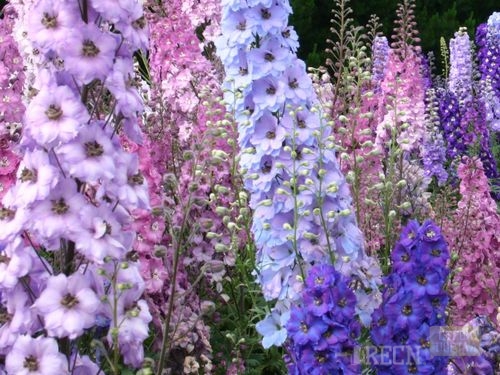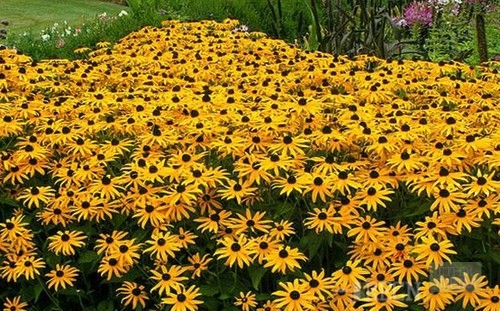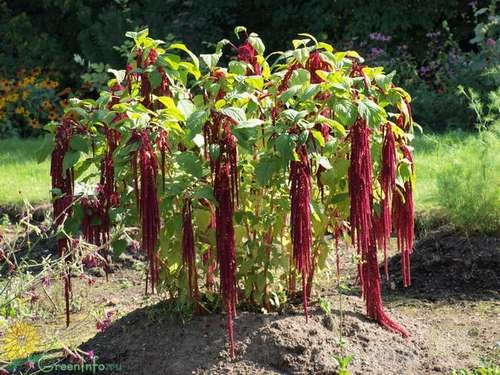
Tall flowers. Landing Rules, Growing and Garden Design Plot.
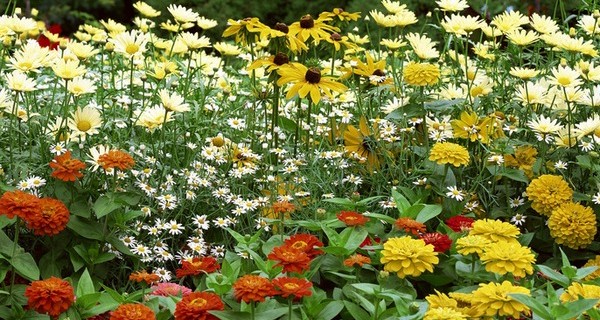
What is like a dolphinium look like, and Lupine in Malva? All gardeners know the answer to this mystery: such different flowers are united by the height! They are the first violins in the motley plant ensemble of any garden: not to notice them is impossible. In this article, you will get acquainted with the most vivid representatives of high-quality colors and handle the necessary minimum to create the most beautiful flower beds in the whole district!
Content
General Principles of Garden Design High Flowers
Tall flowers - for the garden one of the most important elements, which experts consider, gives any site a certain dynamics. Very expressive such plants look in the overall composition of the mixboarder - mixed flower garden. To strengthen the effect of slim hands, in the flowerbed to high colors, only miniature low-alone "neighbors" are planted, trying to bring the color of all petals to the total color range - the contrast here is not to the place. For example, the flowering time of luxurious Malva and gentle lowlands coincide, and the rich color range of these colors allows you to create an unthinkable amount of interesting combinations within the framework of the flower beds.
But the plot of a small size tall flowers can visually "overload". In this case, moderation is relevant: it is better to plant a small number of such colors in different parts of the garden. It is desirable that the color of their petals is set aside in the beddock. The secret is that the bright stains of cream or white buds visually will increase the garden.
Tall flowers for cottages can perform not only decorative, but also a practical task. These noble big plants are perfectly coping with a disguise and prosaic wall of a house or any economic building. The solvent giants will become an excellent living wall - sunflowers. Their bright, but not screaming inflorescences will hide any unsightly iron corner on the site. To do this, they plant them as close as possible so that in the future the plant stood with a solid wall. At the bottom between the sunflowers, low-spirited plants are sure to plant - after a while, their thick "undergrowth" will close not aesthetically called the trunk of the sunflower. The win-win version is the duet of velvetsev with nasturtium.
Features of growing tall colors
- The bloom of tall plants start from mid-summer to late autumn, which is why they drink a lot - that requires a big and strong stalk of the plant. Without a sufficient amount of moisture, it loses the bottom leaves, the flower is gradually drying out, it does not have a small tolly of the former beauty. So that the moisture is instantly evaporated, resort to such an agriculture as mulching. At the foot of the colors lay out 4 - a 5-centimeter layer of chopped to the middle fraction of wood crust.
- Not a very long arid period can "endure" perennials with a rod root system. Among them, Mordovnik, Korovyak, nine, high, rhubarb, Astrance Small and many others.
- Tall flowers with urine root are more demanding on a sufficient amount of moisture in the soil. This Malva Wrinkling, Golden, Vasilek Large, Mackeling, Gelenium, Astra Novobelgian
- Also, high flowers need a reliable support - they must be supported so that they should be under the pressure of a strong wind or heavy rain.
- High flowers are unpretentious - they are satisfied with the usual garden soil. Although the most comfortable conditions for them in deep fertile soil.
- Shadowish representatives among tall colors are not very much, for the most part, they are happy with rich sunshine.
- Tall colors growing in the garden for more than one year, more space is required than low perennials. Therefore, based on the type of high plant, it is necessary to approximately calculate the landing of one flower on 1 or 2 m² - it is so much necessary for nutrition and the full development of a large plant. If the places for planting the colors are very little, you can resort to one tricks, namely, choose for the flower beds of those representatives of tall colors, which by all the forces stretch up, not in the same way in the width (Malva, Cefalaria Alpine).
Tall perennial flowers
High perennials are good both in groups with other blooming plants and as solts. The height of these colors determines their place next to other flowers in the common flowerbed. In this regard, they are divided into gigantic perennials (they grow to height more than 2 m) and high perennials (one and a half - two meters from the ground).
The large sizes of these perennials become their advantage, if they planted them near a neat reservoir, in a group of various types of colors, in picturesque man-made thickets or in proud loneliness.
Tall flowers are excellent companions, they are easy to combine with a variety of perennial plants, they look good among major cereals, create a noble mixture background, if planted in the background. In addition, high perennials dried the land on which they grow, not as much as other living hedges do.
These flowers grow pretty quickly - after their landing "naked" plot will very soon boast a new colorful interior.
Let's get acquainted with several bright representatives of high perennials.
Highlander sparkum
The height of the plant is about 1 - 1.2 m, it grows to a diameter of 80 cm. Red, white or pink small flowers are in fluffy candle inflorescences, closely pressed to each other. Plant plant in May. Gores blooms from August to first frost. Use as an element of jewelry for open soil. Highlander can withstand temperatures to -15 degrees! By winter, his crown of the bush is a bit clipped, and the roots and root neck are hiding under the layer of compost from fallen leaves, sawdust or peat.
Volzhanka Dwarm (ordinary)
An external blooming type of plant makes it look like an astilb. The flower is not capricious, but prefers to be in the shade. The branches of the bush every year grow out of a powerful stem, which is underground, is about 2 m. A large number of miniature snow-white and light yellow buds are combined into wide blizzes, from 20 to 65 cm long. Volzhanka flowers appear in June.
Eremurus Himalayan
Thick meaty rhizome at the initial stage of growth gives a powerful outlet consisting of elongated juicy green leaves, which die some time after the start of flowering. The brushes of snow-white or yellow colors reaches a length of 60 cm and 2.5 cm in volume. Eremurus is growing to 1.8 m from the ground. Flowering falls on June-July, the eremurus can be propagated using seeds. The plant prefers a nourishing garden primer and a rich sun, winter needs shelter. It looks great both alone and in the company of other colors.
Heliantus, or sunflower
The high altar pleases the eye with original golden-brown saucers, which reach 6 to 7 cm in circle. Flowers bloom in August, keep all the beginning of autumn. Heliantus rushes up to 2.5 m - it is noticeable in the district. It has good tolerance of cold weather.
Purple preoccupus
A large, but compact plant that behaves decently - does not scatter in the garden, does not need winter shelter. This luxurious bush in height reaches one and a half meters. In July-August, the ends of the shoots are decorated with sweaty inflorescences of small buds of saturated dark pink color. Their shade is constantly changing. Embosnik - a modest perennial, will not refuse partial dimming. The fresh and fertrige than the soil in the garden, the more bush and more of his inflorescence.
Malva, or rose rose
There is a huge number of varieties, among which are annual and two-year. True, they are positioning them as perennials - due to self-sighted property. The height of Malva varies from 65 - 70 cm to an impressive 1.5 - 2 m. The flowers of the rose rose will not leave anyone indifferent - there are no such charming nonachhrovaya, semi-world and terry petals of all kinds of colors anymore any other plant! Seeds of Malva are sown immediately into the soil in mid-May. At the end of the summer or at the very beginning of the fall, the plants can be seeded for permanent places, adhering to a distance of 35 - 40 cm. This perennial will never give up abundant irrigation, especially in dry weather. He loves the sun and fertile loose soil.
Tall annual flowers
Annual, as you can guess by the name, decorate our blooming garden just one season. These short-life, these spectacular high plants compensate that they grow rapidly (seeds are planted in March) and blooming all summer and part of the autumn to the first frosts, the transformation area in the blink of an eye. Restores, although they love well-lit places, can adapt to the half, just no need to forget to regularly feed them.
These half-and-half meter beauties can adequately grow separately from the rest of the colors: against the background of juicy green grass or lawn, delphiniums, terry Malva or Kreghevin will look like the natural work of art. However, if you wish to grow high annuals on a common flower bed, they will organically fit into any distortion. It is necessary to plant them as the background of the general composition of the mixboarder. For example, snow-white flowers, duture bells become a "highlight" of any flower beds.
Tall flowers in the photo laid out below - annual. Any novice gardener can choose something for yourself.
Kleschevin
Russian palm, as they still love to call a plant, grows with a three-meter wonderful tree with impressive sizes with wide and empty leaves. The blooming "candle" of Kleschinye is an unforgettable spectacle. The plant loves the sultry sun and does not tolerate cold.
Grow the annual from seeds who sow in peat pots in March or April. Before the immediate landing can be 2 - 3 hours to withstand seeds in a solution that stimulates growth. The first sprouts appear on average three weeks. Before planting the ticklaith to a permanent place, rate whether the selected area is enough - the distance between the individual trees of the plant should be at least 1 meter, otherwise they will be closely. It is easier to care for the ticklaith simpler - regular watering, good drainage, frequent loosening and mandatory garter. That's all she needs.
Dolphinium Ajax
This beautiful plant reaches a height of about 1 m. His thick and dense inflorescences are very diverse in bloom: pink, red, white, blue, purple. Flowers are sometimes used when drawing up dry bouquets. Blue and blue dolphinium flowers after drying are not flexible.
The annual seeds are immediately planted in the open soil in March-April. Dolphinium does not like straight sunlight, preferring scattered lighting. Water drinks moderately, in the arid period, watering makes more frequent. 1 time in 14 days all the time that blooms the plant, it is fed by mineral fertilizers. Very high instances are tied to a reliable support.
Rudbeckia
This beautiful flower plant is appreciated for active vegetation and long-lasting flowering. The bright colors of the annual magnet attract the look, wherever they grow, especially since the height of the plant (from 70 cm to 2 m) allows it to stand out in any corner of the garden.
Rudbecki's growing is not complicated - this is not a mustleful plant. It is suitable for solar territories of fertile wet land and a slight shadow. Seeds are sown in the boxes with the arrival of April, in the soil placed in May. In addition, Rudbeckia is still multiplied by the division of the bush and rhizomes. The plant watered moderately, some of its kinds can hold out without water long enough. Throughout the growing season period, Rudbecky 3 times feed the complex mineral fertilizer.
Amaranth
It is a three-meter giant with large and bright inflorescences - panicles. It is completely unpretentious in leaving - takes good in any soil. The main thing for him is light, Amaranth loves open sunny sections.
This resistant annual withstands the temperature drop to 0 ° C. Seeds are planted in open soil in May, the distance between future plants should be about 40 cm. Amaranth care is simple: moderate watering and regular soil looser. Flower does not tolerate water stagnation. So that the branches of the annual thicker crumble, at the end of June its top pinch.




